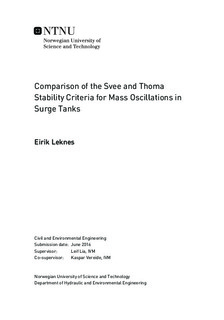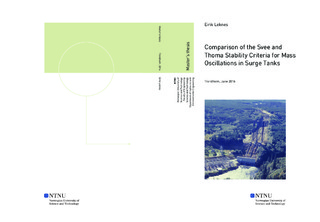| dc.description.abstract | This thesis discusses two different criteria for the stability of surge tanks in hydropower plants. In 1910, the first stability criterion was derived by Dieter Thoma. This criterion sets a minimum cross-sectional area for a surge tank to give stable conditions for the power plant. The criterion was put into use, but was found to give inaccurate results, and later modified. In 1970, Hallbjørn Roald Svee derived a second stability criterion, improving on the inaccuracy by including several factors that Thoma had left out. Svee s criterion was written as a reply to bad results in using the Thoma criterion for the stability of a surge tank in Brazil. However, after its use by Svee himself, the criterion has not been put into widespread use. The derivation of the two criteria are presented side by side, where both criteria have been rewritten to a modern form and non-explained steps from the original sources are derived.
To test the criterion, three studies were carried out. A parameter sensitivity analysis, a case study of Kvinen power plant and a one-dimensional numerical simulation on the same power plant, comparing the Thoma and Svee criteria. For the parameter sensitivity study, most of the results show the Svee criterion giving a smaller surge tank area than the Thoma criterion. A smaller surge tank is easier and less expensive to construct. The only parameter giving an opposite result is the turbine efficiency. For a system operating on a load higher than the best efficiency point, the Svee criterion gives a larger area. The area of the tunnels in the system is found to be the parameter most influential on the area of a stable surge tank.
The case study shows similar results, smaller surge tanks for Svee except in high load cases. The numerical simulation shows slow dampening of the mass oscillations for a system dimensioned after the Thoma criterion, and unstable oscillations for the Svee criterion. This should imply that the Svee criterion gives a surge tank design that is unstable, but the limitations of a numerical simulation suggests a physical model test should be performed. | |

